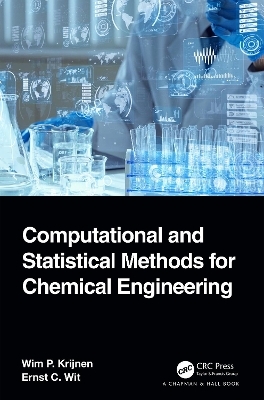
Computational and Statistical Methods for Chemical Engineering
Chapman & Hall/CRC (Verlag)
978-1-032-01324-4 (ISBN)
In the recent decades, the emerging new molecular measurement techniques and their subsequent availability in chemical database has allowed easier retrieval of the associated data by the chemical analyst. Before the data revolution, most books focused either on mathematical modeling of chemical processes or exploratory chemometrics. Computational and Statistical Methods for Chemical Engineering aims to combine these two approaches and provide aspiring chemical engineers a single, comprehensive account of computational and statistical methods.
The book consists of four parts:
Part I discusses the necessary calculus, linear algebra, and probability background that the student may or may not have encountered before.
Part II provides an overview on standard computational methods and approximation techniques useful for chemical engineering systems.
Part III covers the most important statistical models, starting from simple measurement models, via linear models all the way to multivariate, non-linear stochiometric models.
Part IV focuses on the importance of designed experiments and robust analyses.
Each chapter is accompanied by an extensive selection of theoretical and practical exercises. The book can be used in combination with any modern computational environment, such as R, Python and MATLAB. Given its easy and free availability, the book includes a bonus chapter giving a simple introduction to R programming.
This book is particularly suited for undergraduate students in Chemical Engineering who require a semester course in computational and statistical methods. The background chapters on calculus, linear algebra and probability make the book entirely self-contained. The book takes its examples from the field of chemistry and chemical engineering. In this way, it motivates the student to engage actively with the material and to master the techniques that have become crucial for the modern chemical engineer.
Wim P. Krijnen is a lecturer at the Faculty of Science and Engineering at the University of Groningen. He has been teaching a course called "Computational and Statistical Methods" for several years to undergraduate students in Chemical Engineering. In addition, he has taught courses on linear algebra, probability theory, mathematical statistics, statistical modeling, statistical consulting to bachelor’s and master’s students in various fields. He is a professor of Applied Statistical Research Methods at the Hanze University of Applied Sciences in Groningen. Ernst C. Wit is the Fondazione Leonardo Professor of Data Science at the Universita della Svizzera italiana in Switzerland. He has 30 years of experience in teaching statistics, applied mathematics and data science courses to students from many fields, including chemical engineering. His course in philopsophy is about combining theoretical insights with practical skills, as he believes that the former without the latter is pointless whereas the latter without the former aimless.
I. Preliminaries. 1. What to expect in this book? 2. Calculus and Linear Algebra Essentials. 2.1. Scalars, Vectors and Matrices. 2.2. Sequences and Series. 2.3. Functions. 2.4. Differentiation. 2.5. Maxima and Minima. 2.6. Integration. 2.7. Differential Equations. 2.8. Complex Numbers and Functions. 2.9. Exercises. 3. Probability Essentials. 3.1. Probability of Events. 3.2. Random Variables. 3.3. Pseudo Random Number Generation. 3.4. Notes and Comments. 3.5. Notes on Using R. 3.6. Exercises. II. Numerics and Error Propagation. 4. Introduction to Numerical Methods. 4.1. Fixed Point Problems. 4.2. Numerical Methods for Solving Differential Equations. 4.3. Differential Algebraic Equations. 4.4. Notes and Comments. 4.5. Notes on Using R. 4.6. Exercises. 5. Laws on propagation of Error. 5.1. Absolute and Relative Error of Measurement. 5.2. Mean and Variance. 5.3. Functions that Depend on One Variable. 5.4. Functions that Depend on Two Variables. 5.5. Notes and Comments. 5.6. Notes on Using R. 5.7. Exercises. III. Various Types of Models and their Estimation. 6. Measurement Models for a Chemical Quantity. 6.1. Measurement Model. 6.2. Law of Large Numbers. 6.3. Constructing Confidence Intervals. 6.4. Testing Chemical Hypotheses related to Measurement Models. 6.5. General Inference Paradigm. 6.6. Notes and Comments. 6.7. Notes on Using R. 6.8. Exercises. 7. Linear Models. 7.1. Linear Model. 7.2. Estimation and Prediction. 7.3. Model Diagnostics. 7.4. Model Selection. 7.5. Specific Linear Models. 7.6. Notes and Comments. 7.7. Notes on Using R. 7.8. Exercises. 8. Non-linear Models. 8.1. Some non-linear Functions Modeling chemical Processes. 8.2. Non-linear Regression. 8.3. Inverse Regression. 8.4. Generalized Linear Models. 9. Chemodynamics and Stoichiometry. 9.1. Stoichiometry of Systems of Reactions. 9.2. Stochastic Models for Particle Dynamics. 9.3. Estimating Reaction Rates. 9.4. Mean-field Approximation of Reaction System. 10. Multivariate Exploration. 10.1. Data Visualisation. 10.2. Matrix Decomposition. 10.3. Principal Components Analysis. 10.4. Regression using a Subspace. 10.5. Notes and Comments. 10.6. Notes on Using R. 10.7. Exercises. IV. Analysis of Designed Experiments. 11. Analysis of Data from Designed Experiments. 11.1. Concepts of Factorial Designs. 11.2. Analysis of Variance. 11.3. Analysis of the Response Surface. 11.4. Mixed Effects Models. 11.5. Notes and Comments. 11.6. Notes on Using R. 11.7. Exercises. 12. Robust Analysis of Models. 12.1. Outlying Data Points. 12.2. Robust Estimation. 12.3. Robust Linear Regression. 12.4. Robust Nonlinear Regression. 12.5. Dealing with Heterogeneity. 12.6. Appendix: Scale Tau Estimator. 12.7. Notes and Comments. 12.8. Notes on Using R. 12.9. Exercises. V. Appendix. 13. Basics of R Computing Environment. 13.1. R Basics. 13.2. Useful Functions. 13.3. Model Notation.13.4. Finding Help. 13.5. Exercises
| Erscheinungsdatum | 01.12.2022 |
|---|---|
| Zusatzinfo | 72 Tables, black and white; 66 Line drawings, black and white; 66 Illustrations, black and white |
| Sprache | englisch |
| Maße | 156 x 234 mm |
| Gewicht | 720 g |
| Themenwelt | Mathematik / Informatik ► Mathematik ► Statistik |
| Naturwissenschaften ► Biologie | |
| Naturwissenschaften ► Chemie ► Technische Chemie | |
| Technik ► Umwelttechnik / Biotechnologie | |
| ISBN-10 | 1-032-01324-9 / 1032013249 |
| ISBN-13 | 978-1-032-01324-4 / 9781032013244 |
| Zustand | Neuware |
| Haben Sie eine Frage zum Produkt? |
aus dem Bereich


